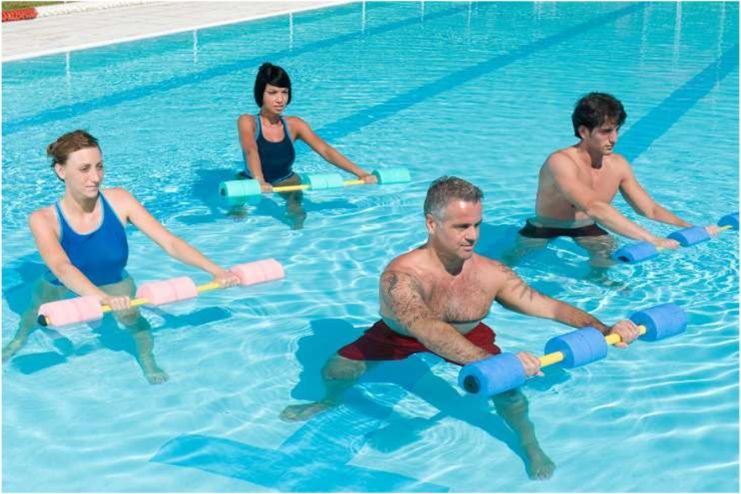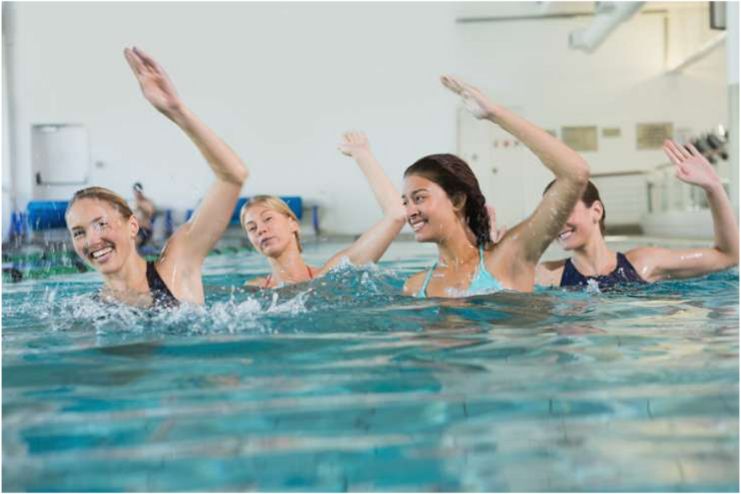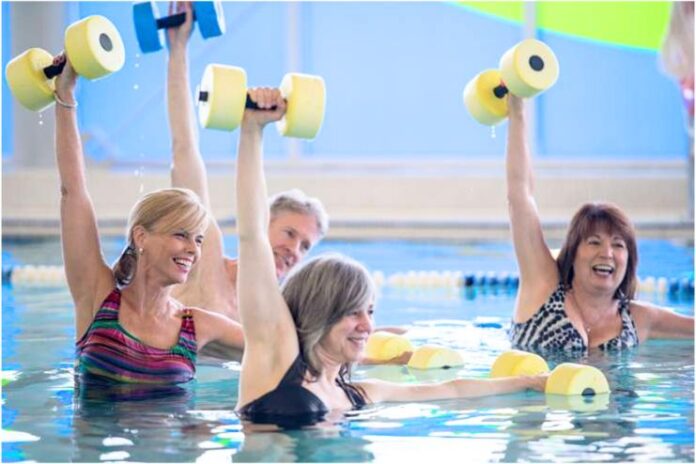Affiliate Disclaimer
Some links in this article are affiliate links. We may earn a small commission if you make a purchase through these links, at no extra cost to you. We only recommend products we find useful to our readersAquatic fitness is a fun and revitalizing workout that uses water’s natural resistance to improve strength, endurance, and flexibility. In contrast to conventional workouts, water-based activities offer a low-impact yet incredibly efficient means of maintaining fitness, making them perfect for people of all ages and fitness levels.
Whether you want to increase muscle mass, strengthen your heart, or recover from an injury, aquatic exercises provide a joint-friendly substitute that minimizes stress while optimizing outcomes.
Aquatic fitness is a great option for people looking for a well-rounded and pleasurable workout regimen because of the water’s calming qualities, which also encourage relaxation and stress relief.
Read More: 10 Top-Rated Cardio Toning Mats: Choose One That Works Best For You
Understanding Aquatic Fitness
Aquatic fitness is a specific type of exercise that uses water’s inherent qualities to improve physical conditioning. It is low-impact and relieves strain on the muscles, joints, and bones. Additionally, water provides natural resistance, which can aid in muscular strengthening.
Numerous health advantages of aquatic exercise include enhanced heart health, less stress, and increased muscular strength and endurance. Depending on their talents and fitness level, each participant can do it at different water depths and intensities.
You can choose from various pool exercises to develop a successful aquatic fitness program. To improve your fitness, you can swim laps in the pool and engage in aerobic exercises like walking and water jogging.
Additionally, you can try water aerobics to increase your flexibility and even your power by strengthening your muscles with the water’s resistance. Aquatic exercises use water’s inherent resistance as an excellent way to improve your fitness routine, benefiting people of all skill levels.
Cardiovascular and Toning Benefits

Aquatic exercise is an excellent option for people seeking a full-body workout since it provides a potent blend of cardiovascular conditioning and muscle toning. Swimming, water jogging, and aqua aerobics are examples of water-based aerobic exercises that are good methods for strengthening your heart and increasing your endurance.
Water’s natural resistance raises the effort needed to move, elevating heart rate while reducing joint strain. People with arthritis, joint discomfort, or mobility limitations might benefit significantly from water exercises since they can perform vigorous aerobic workouts without running the risk of getting hurt.
In addition to burning more calories than you would on land, the resistance you experience in the water helps you train more muscles. Frequent aquatic aerobic exercise improves circulation, lowers blood pressure, and strengthens the heart.
Additionally, due to water’s constant resistance, every movement requires more effort from the muscles, which increases endurance and general fitness.
Read More: 15 Cardio Workouts For Women For A Healthier Well-Being
Types of Water-Based Workouts

Aquatic Cardio Exercises
Water-based cardio activities improve heart health, burn calories, and increase endurance while reducing joint stress.
Water-based aerobics, also known as aqua aerobics, aquarobics, or aquafit, is a form of exercise that combines cardio, strength, and interval training in a pool. This workout is typically performed in waist- to chest-deep water, with participants guided by a qualified instructor and accompanied by motivating music.
Water aerobics offers cardiovascular benefits, elevating your heart rate over an extended period. Unlike traditional strength training, which focuses on building muscle through resistance, water aerobics provides natural resistance from the water, making it a great way to strengthen both your muscles and your cardiovascular system. Even activities that seem more like traditional cardio, such as jumping jacks, are enhanced in the water by this added resistance.
Deep water running, also known as aqua jogging, is a type of cardiovascular exercise that simulates running while submerged in water. Two ways to engage in aqua jogging are to run laps in the pool or run in place while wearing a flotation device around your trunk.
Thanks to a flotation device or running belt, your head stays above the water’s surface while your arms and legs are free to move. Aim for at least waist-high water if you have joint problems in your lower body. Water partially compensates for your body weight, so the deeper you dive, the less impact you will experience.
However, increased water resistance will make walking or jogging more difficult as you move deeper.
Toning and Strength Exercises

Without the pressure of conventional weightlifting, water-based resistance training is an excellent approach to toning and increasing muscle mass. Water’s inherent resistance, about 12 times that of air, puts muscles to the test with each movement, encouraging efficient toning and general body strength.
The use of resistance to muscular contraction to increase anaerobic endurance, strength, and the growth of the body’s skeletal muscles is called resistance training, commonly referred to as strength training or weight training. The idea behind resistance training is that when the body’s muscles undergo stress, they try to overcome the resistance force.
Fitness trends have recently gained much more popularity, and people frequently pay more attention to creative approaches. The idea of water resistance training is gaining traction among experts and social media influencers.
Water resistance training incorporates bicep curls, tricep extensions, and lateral raises using aquatic dumbbells, resistance bands, or even the water’s natural resistance. These exercises are perfect for people of all fitness levels because they focus on the upper body while reducing joint strain.
Leg lifts use the water’s resistance to work every leg muscle. You stand in the water and raise one leg to the front, side, or back, working the thighs, glutes, and core muscles.
Stand in the pool, raise one leg to the side, then lower it back down to complete the workout. Continue until your leg is fatigued, then swap legs and work out the other leg. This workout strengthens your core and enhances balance in addition to working your legs.
Read More: 5 Cardio Workouts For Weight Loss At Home
The Unique Benefits of Aquatic Workouts

- Joint Relief: According to a March 2022 study, water aerobics assisted people with osteoarthritis and those who were overweight in finding relief from joint stress. The survey found that the buoyancy of water helps to maintain the body’s weight, which lessens joint effects and pain levels.
- Brain Health: Water aerobics strengthens your body and mind. Forming new neural connections helps maintain a healthy brain at any age, and you can achieve this by learning to perform a sequence of movements as part of a routine.
- Full-Body Workout: Because of the inherent resistance in water, exercises can be more intensive than those on land. Even easy activities like running or walking burn more calories in water. Swimming strokes like freestyle, breaststroke, and backstroke train all the major muscle groups at once, giving your body a full-body workout for optimal effect.
- Heart Health: Water aerobics is a heart-healthy sport. As you progress through the workout, your heart rate rises, and your breathing becomes labored. Regular water aerobics sessions can enhance your body’s ability to tolerate a higher heart rate and cardiovascular expenditure, ultimately increasing cardiovascular fitness.
- Rehab and Arthritis Relief: Exercises in the water are well known for their ability to help people recover. With water rehabilitation therapy, people with physical injuries can move about more easily, recover more quickly, and experience almost no discomfort. Water exercise benefits those with arthritis since it helps them support their body weight.
- Core Strength: As we age, our core strength may deteriorate if we become sedentary. However, core strength is essential for everyday tasks like ascending stairs, standing up from a seated position, and maintaining our balance when walking. When performing water aerobics exercises correctly, the body must use its core to maintain balance and stability—the water’s additional resistance forces you to activate your core with every move.
Read More: Amazing Exercises for Toned Arms
Conclusion
Low-impact but extremely effective workouts are unique and efficient ways aquatic fitness can enhance general health. While weight training and toning activities assist in building muscle and increasing flexibility, water-based aerobic exercises boost heart health, endurance, and calorie burning.
Including aquatic training in your regimen offers a revitalizing and healing way to maintain your activity level. Exercises involving water provide a safe, entertaining, and efficient way to improve health, whether the goal is weight loss, rehabilitation, or overall well-being.
References
- https://www.mayoclinichealthsystem.org/hometown-health/speaking-of-health/aquatic-exercise-healthy-easy-on-the-body
- https://www.spaworld.com.au/learn/what-is-aqua-fitness-health-benefits-pool-workouts/
- https://www.mayoclinic.org/healthy-lifestyle/fitness/in-depth/aquatic-exercise/art-20546802
- https://www.health.harvard.edu/healthbeat/advantages-of-water-based-exercise
- https://www.betterhealth.vic.gov.au/health/healthyliving/swimming-health-benefits
- https://www.healthline.com/health/fitness-exercise/pool-exercises
- https://www.health.harvard.edu/healthbeat/basic-types-of-water-based-exercise
- https://www.mayoclinic.org/healthy-lifestyle/fitness/in-depth/aquatic-exercise/art-20546802
- https://www.aquajogger.com/aqua-jogging-workouts-are-seriously-tough-heres-how-to-dive-in-for-amazing-fitness-results/
- https://www.healthline.com/health/aqua-jogging
- https://plungesandiego.com/10-benefits-water-resistance-training/
- https://www.health.harvard.edu/healthbeat/advantages-of-water-based-exercise
- https://dan.org/alert-diver/article/pool-exercises/
- https://www.franciscanhealthfitnesscenters.org/content/5-aqua-exercises-get-you-back-shape
- https://pmc.ncbi.nlm.nih.gov/articles/PMC8955208/
- https://newsroom.clevelandclinic.org/2024/07/09/health-benefits-of-water-exercise
- https://www.webmd.com/fitness-exercise/a-z/water-aerobics
- https://www.livestrong.com/article/273601-pros-cons-of-water-aerobics/
In this Article














